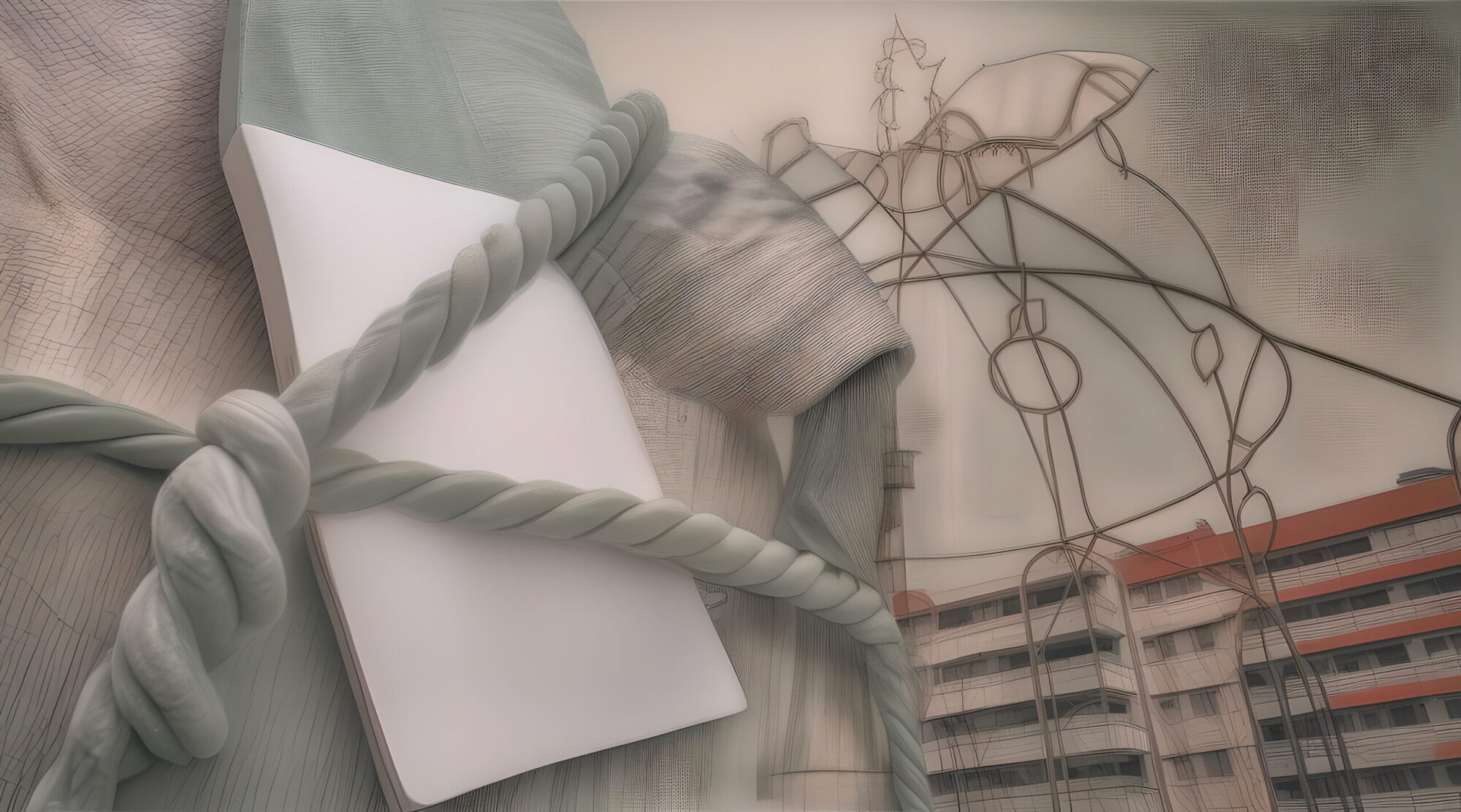1. Visual Analysis
This image is an intricate blend of reality and abstraction. It captures the essence of tension, balance, and surreal juxtaposition through elements both organic and manmade.
- Composition:
The composition is marked by its visual layering—a thick, twisted rope pulls taut across the frame, leading the viewer’s eye to intersecting planes. In the background, abstract linework creates fluid geometry, while architectural elements of buildings anchor the image to reality. The scene feels meticulously arranged, evoking purpose but also unease. - Color:
A muted palette of soft greens, greys, and beige creates a calm, almost dreamlike mood. Subtle red accents from the distant buildings break the stillness, hinting at hidden vibrancy beneath the quiet tones. - Texture:
The image thrives on contrasting textures: the coarse surface of the twisted rope, the smooth sheen of the paper-like surface, and the rigid, linear grid of the buildings. The interplay between tactile roughness and polished surfaces adds to the overall tension. - Light and Shadow:
Soft, diffused light blankets the entire scene, creating an ethereal quality. Shadows cast by the rope deepen the sense of dimension, while the background architecture emerges as if through a fog—familiar, yet unreachable.
2. A Study in Contrast
The photograph dances between contrasts: tension and release, solidity and abstraction, clarity and distortion.
- The rope pulls tautly, exerting a physical presence, while the surrounding lines and shapes seem weightless, untethered by gravity. The composition invites us to ask: What holds us in place? What sets us free?
- The architecture represents order and structure, but its warped reflections dissolve that clarity. Reality bends, softened by an unseen force—perhaps memory, or perception itself.
- The twisting lines suggest a human touch: deliberate, sculptural, almost organic. Yet, the buildings remind us of urban rigidity and permanence. Together, they explore how art and structure coexist, blurring their boundaries.
3. The Photographer’s Eye
This image showcases a masterful use of perspective and abstraction. The photographer guides us to reinterpret the ordinary through deliberate choices:
- Leading Lines:
The rope dominates the frame as a visual guide, drawing us diagonally from the lower left to the upper right, breaking through layers of reality. Its tension pulls the scene together, anchoring disparate elements. - Depth of Field:
The shallow depth of field softens the background, turning the grid of buildings into a hazy, dreamlike backdrop while keeping the rope and surface sharply defined. - Framing and Angles:
The unconventional angle tilts the viewer’s perspective, enhancing the disorientation. Architecture feels both distant and looming—simultaneously familiar and strange. - Minimalism Meets Complexity:
Despite its layered abstraction, the image avoids clutter. It strips reality down to its essentials: rope, paper, and shadow—each telling its own story while working in harmony.
4. The Zen Perspective
The rope and the warped architecture create a visual koan—something that resists immediate understanding, inviting us instead to pause, reflect, and accept the ambiguity.
- Tension as Stillness:
The rope, despite its tautness, feels calm. It becomes a symbol of balance—of forces held together in harmony rather than conflict. - The Illusion of Control:
The buildings appear distorted, as if bending to forces beyond their control. This subtle chaos reminds us that our rigid structures—mental or physical—are not immutable. To resist change is to create suffering; to embrace it is to find peace. - Art as Connection:
The braided rope, the soft geometric forms, and the distant buildings speak of connection—between human creativity and the natural world, between what is grounded and what is free to move. It reflects the Zen principle of interdependence: nothing exists alone.
5. Reflections for the Viewer
This image is not just a visual experience; it’s an invitation to look beyond surfaces.
- It asks us to find beauty in tension—to see that balance often requires holding opposing forces.
- It reminds us that clarity comes not from rigid order but from surrendering to ambiguity.
- For photographers, it demonstrates the power of perspective, abstraction, and composition in elevating the ordinary to something contemplative and profound.
As the eye follows the rope’s pull, we are reminded: the threads we hold may not define us, but they connect us—each knot a moment, each twist a story, each release a letting go.

